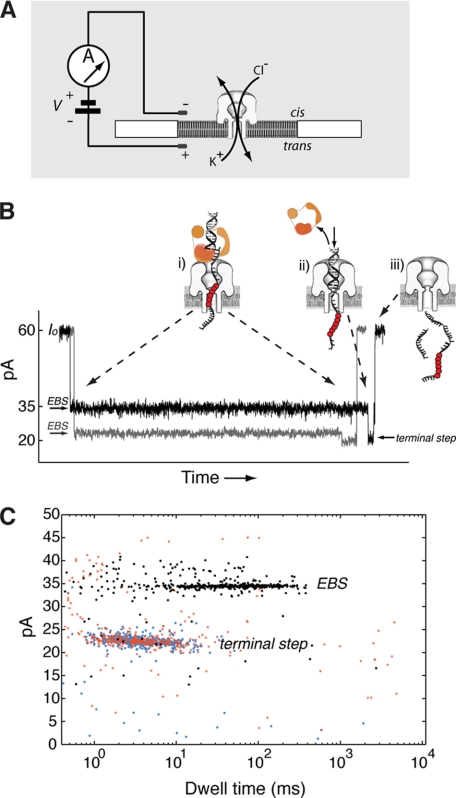FIGURE 2.
Detection of KF-DNA complexes with the α-HL nanopore. A, the nanopore instrument. A single α-HL nanopore is inserted in a ∼25-μm-diameter lipid bilayer, which separates two chambers (cis and trans) containing buffer solution. Current through the nanopore is carried by K+ and Cl− ions. A patch clamp amplifier applies voltage and measures ionic current. B, ionic current blockade structure for the capture of a KF-DNA complex. The gray current trace corresponds to capture of a KF-DNA complex formed with a substrate composed solely of standard DNA residues. The black trace is for capture of a KF-DNA complex formed with a substrate bearing an insert of abasic residues in the template strand. The molecular events corresponding to each current level are illustrated in schematics i–iii (11, 13). The abasic residues are indicated as red circles. The initial longer blockade (i) is the EBS observed upon capture of a KF-DNA complex with the duplex DNA held atop the pore vestibule by the polymerase (11). The amplitude of this initial segment is increased when abasic residues are positioned to reside in the nanopore lumen during the EBS (13). The shorter, lower amplitude segment (terminal step; ii) occurs when the force of the electric field pulling on the template strand causes dissociation of KF from the DNA and the duplex DNA is drawn into the nanopore vestibule (11). Electrophoresis of the unbound DNA through the nanopore (iii) restores the open channel current (60 ± 2 pA at 180 mV in buffer containing 0.3 m KCl). C, representative dwell time versus amplitude plot for an experiment in which KF-DNA complexes were captured at 180-mV applied potential. Ionic current blockades were quantified with software developed in our laboratory that identifies the dwell time and amplitude of the EBS segments of events (black points) and their corresponding terminal step segments (blue points). The red points indicate events for which a terminal step in the ionic current blockade was not detected. These unbound DNA events have the same amplitude and duration as the terminal current steps.

